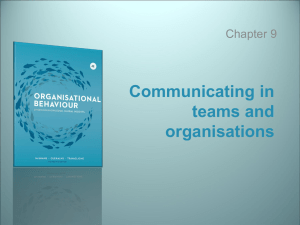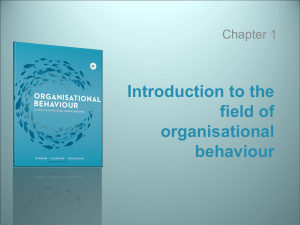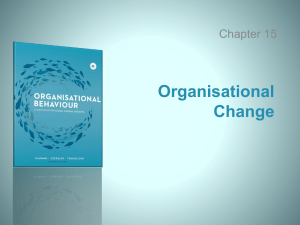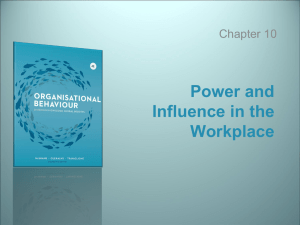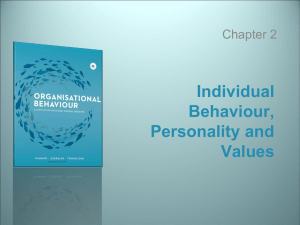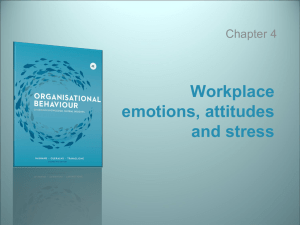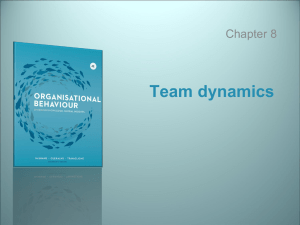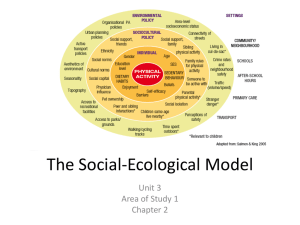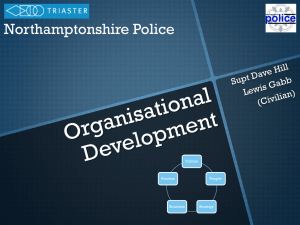PPT_McShane4e_Ch07 - PMS 2123_Organizational Behaviour
advertisement
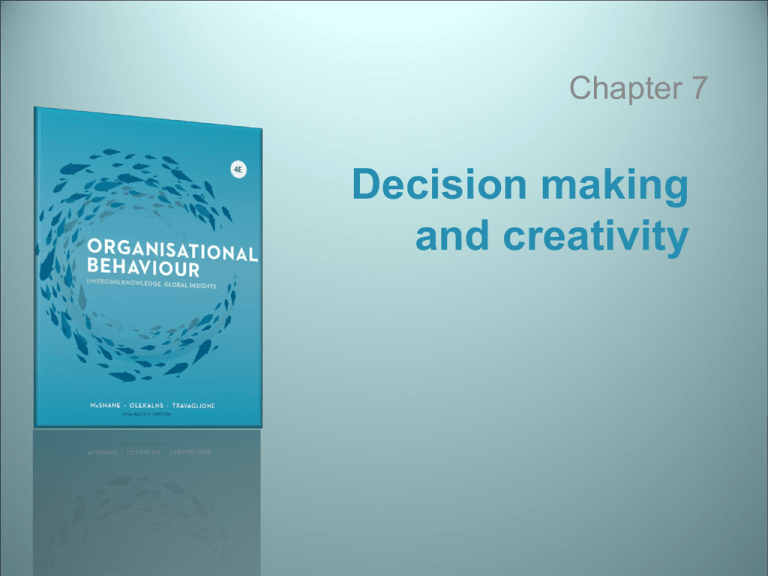
Chapter 7 Decision making and creativity Learning Objectives 7.1 Describe the rational choice paradigm 7.2 Explain why people differ from the rational choice paradigm when identifying problems/opportunities, evaluating/choosing alternatives and evaluating decision outcomes 7.3 Discuss the roles of emotions and intuition in decision making 7.4 Describe employee characteristics, workplace conditions and specific activities that support creativity 7.5 Describe the benefits of employee involvement and identify four contingencies that affect the optimal level of employee involvement Copyright © 2013 McGraw-Hill Australia Pty Ltd McShane, Olekalns, Travaglione, Organisational Behaviour, 4e 7-2 Decision Making at HP At HP technicians moved from being problem solvers to having the autonomy to embrace entrepreneurialism in customer service. Through training, the company developed the technicians’ enthusiasm, ability and skills, resulting in happy costumers and employees Copyright © 2013 McGraw-Hill Australia Pty Ltd McShane, Olekalns, Travaglione, Organisational Behaviour, 4e 7-3 Decision Making Defined Decision making is a conscious process of making choices among one or more alternatives, with the intention of moving toward some desired state of affairs Copyright © 2013 McGraw-Hill Australia Pty Ltd McShane, Olekalns, Travaglione, Organisational Behaviour, 4e 7-4 Rational Choice Paradigm • Rational choice paradigm: effective decision makers identify, select and apply the best possible alternative • Two key elements of rational choice 1. Subjective expected utility: determines choice with highest value (maximisation) 2. Decision-making process: systematic application of stages of decision making Copyright © 2013 McGraw-Hill Australia Pty Ltd McShane, Olekalns, Travaglione, Organisational Behaviour, 4e 7-5 Subjective Expected Utility Estimating the best possible alternative (maximisation) Expected—probability of an outcome occurring • E.g. chance that outcome 3 will occur is 90% if choice ‘A’ is chosen, 30% if choice ‘B’ is chosen Utility—value or happiness produced by each option from value of expected outcomes • Choice ‘B’ has higher utility (value) than choice ‘A’ • Choice ‘B’ expected utility is (0.8×7)+(0.2×–2)+(0.3×1)=6.4 Copyright © 2013 McGraw-Hill Australia Pty Ltd McShane, Olekalns, Travaglione, Organisational Behaviour, 4e 0.2 Choice A 0.5 Outcome 1 (+7) Outcome 2 (-2) 0.9 Outcome 3 (+1) 0.8 Choice B 0.2 Outcome 1 (+7) Outcome 2 (-2) 0.3 Outcome 3 (+1) Probability of outcome occurring Utility (expected happiness) 7-6 Rational Choice Decision Process Copyright © 2013 McGraw-Hill Australia Pty Ltd McShane, Olekalns, Travaglione, Organisational Behaviour, 4e 7-7 Rational Choice Decision Process • Identify problem or opportunity – Symptom vs problem • Choose decision process – E.g. (non) programmed • Develop/identify alternatives – Search, then develop • Choose best alternative – Subjective expected utility • Implement choice • Evaluate choice Copyright © 2013 McGraw-Hill Australia Pty Ltd McShane, Olekalns, Travaglione, Organisational Behaviour, 4e 7-8 Problems with the Rational Choice Paradigm • The model assumes that people are efficient and logical information-processing machines • In reality, people have difficulty recognising problems and failures and cannot simultaneously process huge volumes of information • The model focuses on logical thinking and completely ignores emotions Copyright © 2013 McGraw-Hill Australia Pty Ltd McShane, Olekalns, Travaglione, Organisational Behaviour, 4e 7-9 Identifying Problems and Opportunities • Stakeholder framing • Mental models • Decisive leadership • Solution-focused problems • Perceptual defence Copyright © 2013 McGraw-Hill Australia Pty Ltd McShane, Olekalns, Travaglione, Organisational Behaviour, 4e 7-10 Identifying Problems and Opportunities Effectively 1.Be aware of perceptual and diagnostic limitations 2.Fight against pressure to look decisive 3.Maintain ‘divine discontent’ (aversion to complacency) 4.Discuss the situation with colleagues—see different perspectives Copyright © 2013 McGraw-Hill Australia Pty Ltd McShane, Olekalns, Travaglione, Organisational Behaviour, 4e 7-11 Making Choices: Rational vs OB Views Rational choice paradigm assumptions Observations from organisational behaviour Goals are clear, compatible and agreed upon Goals are ambiguous, conflicting and lack agreement People are able to calculate all alternatives and their outcomes People have limited information processing abilities People evaluate all alternatives simultaneously People evaluate alternatives sequentially Copyright © 2013 McGraw-Hill Australia Pty Ltd McShane, Olekalns, Travaglione, Organisational Behaviour, 4e 7-12 Making Choices: Rational vs OB Views continued Rational choice paradigm assumptions Observations from organisational behaviour People use absolute standards to evaluate alternatives People evaluate alternatives against an implicit favourite People make choices using factual information People make choices using perceptually distorted information People choose the alternative with the highest payoff (SEU) People choose the alternative that is good enough (satisficing) Copyright © 2013 McGraw-Hill Australia Pty Ltd McShane, Olekalns, Travaglione, Organisational Behaviour, 4e 7-13 Biased Decision Heuristics People have built-in decision heuristics that bias evaluation of alternatives 1. Anchoring and adjustment—initial information (e.g. opening bid) influences evaluation of subsequent information 2. Availability heuristic—we estimate probabilities by how easily we can recall the event, even though other factors influence ease of recall 3. Representativeness heuristic—we estimate probabilities by how much they are similar to something else (e.g. stereotypes) even when better information about probabilities is available Copyright © 2013 McGraw-Hill Australia Pty Ltd McShane, Olekalns, Travaglione, Organisational Behaviour, 4e 7-14 Paralysed by Choice • Decision makers are less likely to make any decision at all as the number of options increases • Occurs even when there are clear benefits to selecting any alternative (such as joining a company retirement plan) • Evidence of human information processing limitations Courtesy of Microsoft Copyright © 2013 McGraw-Hill Australia Pty Ltd McShane, Olekalns, Travaglione, Organisational Behaviour, 4e 7-15 Emotions and Making Choices 1.Emotions form preferences before we consciously evaluate those choices 2.Moods and emotions influence how well we follow the decision process 3.We ‘listen in’ on our emotions and use that information to make choices Copyright © 2013 McGraw-Hill Australia Pty Ltd McShane, Olekalns, Travaglione, Organisational Behaviour, 4e 7-16 Intuitive Decision Making • Ability to know when a problem or opportunity exists and select the best course of action without conscious reasoning • Intuition as emotional experience – Gut feelings are emotional signals – Not all emotional signals are intuition • Intuition as rapid non-conscious analysis – Uses action scripts Copyright © 2013 McGraw-Hill Australia Pty Ltd McShane, Olekalns, Travaglione, Organisational Behaviour, 4e 7-17 Making Choices More Effectively • Systematically evaluate alternatives against relevant factors • Be aware of effects of emotions on decision preferences and evaluation process • Scenario planning Copyright © 2013 McGraw-Hill Australia Pty Ltd McShane, Olekalns, Travaglione, Organisational Behaviour, 4e 7-18 Implementing Decisions • Execution—translating decisions into action—is one of the most important and challenging tasks of leaders Copyright © 2013 McGraw-Hill Australia Pty Ltd McShane, Olekalns, Travaglione, Organisational Behaviour, 4e 7-19 Evaluating Decision Outcomes • Post-decisional justification is the tendency to inflate the quality of the selected option, and forget or downplay rejected alternatives • Caused by need to maintain a positive self-concept • Initially produces excessively optimistic evaluation of decision Copyright © 2013 McGraw-Hill Australia Pty Ltd McShane, Olekalns, Travaglione, Organisational Behaviour, 4e 7-20 Escalation of Commitment • The tendency to repeat an apparently bad decision or allocate more resources to a failing course of action • Four main causes of escalation: – – – – Self-justification Prospect theory effect Perceptual blinders Closing costs Copyright © 2013 McGraw-Hill Australia Pty Ltd McShane, Olekalns, Travaglione, Organisational Behaviour, 4e 7-21 Evaluating Decisions More Effectively • Separate decision choosers from evaluators • Establish a preset level to abandon the project • Find sources of systematic and clear feedback • Involve several people in the evaluation process Copyright © 2013 McGraw-Hill Australia Pty Ltd McShane, Olekalns, Travaglione, Organisational Behaviour, 4e 7-22 Creativity at Google Google encourages its engineers to use 20% of their time to develop projects of their choosing The company initially allocates limited resources to initiatives, then assigns more people and budget to projects that show progress and viability, like Google Maps Copyright © 2013 McGraw-Hill Australia Pty Ltd McShane, Olekalns, Travaglione, Organisational Behaviour, 4e 7-23 Creativity Defined • Developing an original idea that makes a socially recognised contribution • Applies to all aspects of the decision process—problems, alternatives, solutions Copyright © 2013 McGraw-Hill Australia Pty Ltd McShane, Olekalns, Travaglione, Organisational Behaviour, 4e 7-24 Creativity Copyright © 2013 McGraw-Hill Australia Pty Ltd McShane, Olekalns, Travaglione, Organisational Behaviour, 4e 7-25 Characteristics of Creative People Copyright © 2013 McGraw-Hill Australia Pty Ltd McShane, Olekalns, Travaglione, Organisational Behaviour, 4e 7-26 Organisational Conditions Supporting Creativity • • • • Learning orientation in the organisation Forgiveness for mistakes Creating intrinsically motivating jobs Open communication and sufficient resources • A reasonable level of job security • Support from leaders and co-workers Copyright © 2013 McGraw-Hill Australia Pty Ltd McShane, Olekalns, Travaglione, Organisational Behaviour, 4e 7-27 Creative Work Environments • Learning orientation – Encourage experimentation – Tolerate mistakes • Intrinsically motivating work – Task significance, autonomy, feedback • Open communication and sufficient resources • Unclear/complex effects of team competition and time pressure on creativity Copyright © 2013 McGraw-Hill Australia Pty Ltd McShane, Olekalns, Travaglione, Organisational Behaviour, 4e 7-28 Creative Activities Redefine the problem Associative play Crosspollination • Review abandoned projects • Storytelling • Diverse teams • Artistic activities • Explore issue with other people • Morphological analysis • Information sessions Copyright © 2013 McGraw-Hill Australia Pty Ltd McShane, Olekalns, Travaglione, Organisational Behaviour, 4e • Internal tradeshows 7-29 Double Circle Problem Copyright © 2013 McGraw-Hill Australia Pty Ltd McShane, Olekalns, Travaglione, Organisational Behaviour, 4e 7-30 Nine Dot Problem Copyright © 2013 McGraw-Hill Australia Pty Ltd McShane, Olekalns, Travaglione, Organisational Behaviour, 4e 7-31 Nine Dot Problem Revisited Copyright © 2013 McGraw-Hill Australia Pty Ltd McShane, Olekalns, Travaglione, Organisational Behaviour, 4e 7-32 Word Search FCIRVEEALTETITVEERS Copyright © 2013 McGraw-Hill Australia Pty Ltd McShane, Olekalns, Travaglione, Organisational Behaviour, 4e 7-33 Burning Ropes After first rope burned i.e. 30 min. One Hour to Burn Completely Copyright © 2013 McGraw-Hill Australia Pty Ltd McShane, Olekalns, Travaglione, Organisational Behaviour, 4e 7-34 Employee Involvement Defined • The degree to which employees influence how their work is organised and carried out • Different levels and forms of involvement: – – – – – Decide alone Receive information from individuals Consult with individuals Consult with the team Facilitate the team’s decision Copyright © 2013 McGraw-Hill Australia Pty Ltd McShane, Olekalns, Travaglione, Organisational Behaviour, 4e 7-35 Employee Involvement Model Copyright © 2013 McGraw-Hill Australia Pty Ltd McShane, Olekalns, Travaglione, Organisational Behaviour, 4e 7-36 Contingencies of Involvement Higher employee involvement is better when: Decision structure • Problem is new and complex (i.e. Non-programmed decision) Knowledge source • Employees have relevant knowledge beyond leader Decision commitment • Employees would lack commitment unless involved Risk of conflict 1. Norms support firm’s goals 2. Employee agreement likely Copyright © 2013 McGraw-Hill Australia Pty Ltd McShane, Olekalns, Travaglione, Organisational Behaviour, 4e 7-37 Summary • The rational choice paradigm relies on subjective expected utility to identify the best choice, but it has limitations • Emotions and intuition also have an important role, not just our rational decision-making • Creativity is the development of original ideas that make a socially recognised contribution. The four creativity stages are preparation, incubation, insight and verification • In the right conditions, employee involvement can contribute greatly to the decision-making process, as well as to the employees and the organisation Copyright © 2013 McGraw-Hill Australia Pty Ltd McShane, Olekalns, Travaglione, Organisational Behaviour, 4e 7-38 Chapter 7 Decision making and creativity
